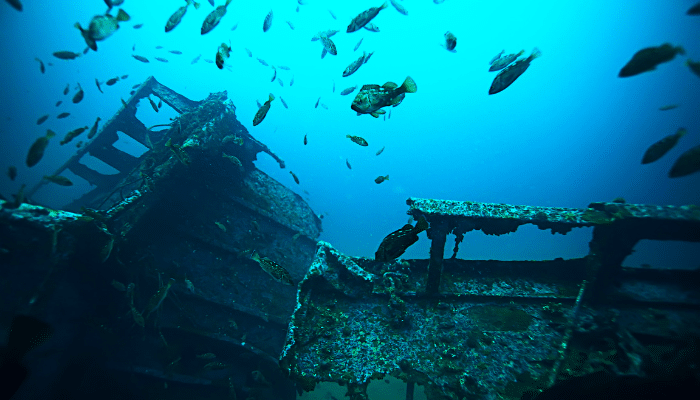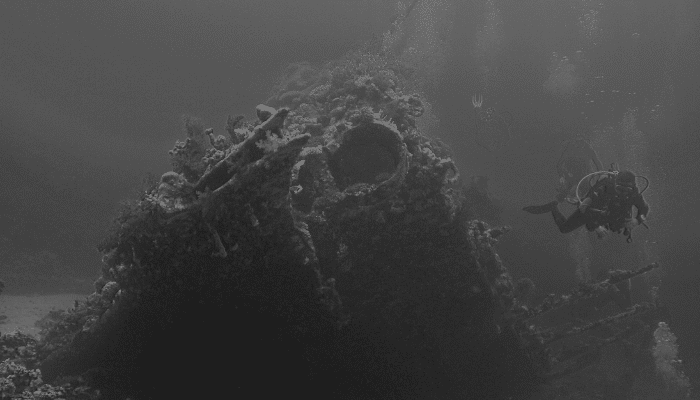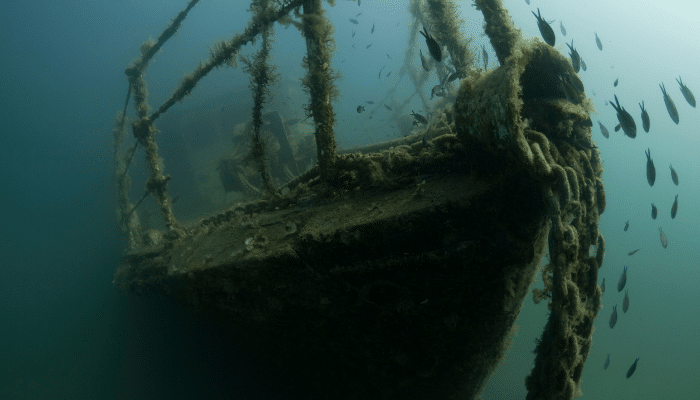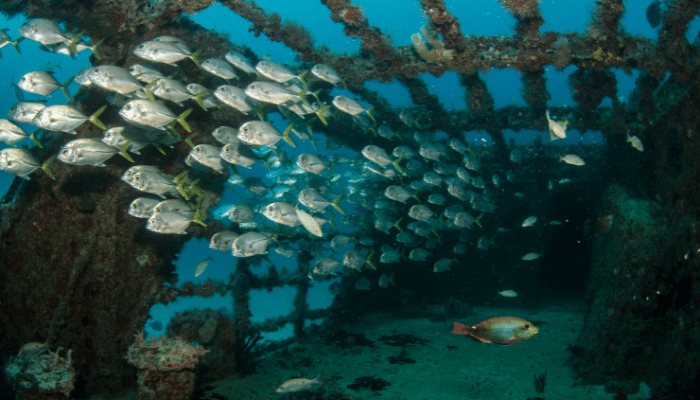10 Atocha Shipwreck Facts
Nuestra Señora de Atocha was a treasure galleon that belonged to the Spanish Navy. It played a vital role in carrying precious goods and materials from the New World to Spain, which made the latter the most powerful nation in Europe from the 15th to 17th centuries.
Atocha was not just any ship; it was the almiranta or the rear guard ship of the 1622 Spanish Treasure Fleet. It trailed behind other ships of the fleet to prevent an attack from the rear. Hence, Atocha was quite heavily armed.

The fleet left Havana with treasures and met a hurricane on September 6, 1622. Eight ships of the 28-ship fleet were lost and ultimately wrecked on the reef between the Dry Tortugas and the Key West.
The Atocha Shipwreck, said to contain one of the richest treasures, was found in 1985 and yielded invaluable finds.
Read along to learn 10 interesting Atocha Shipwreck Facts.
1. Atocha was constructed for the Spanish Crown
Built in 1620 for the Spanish Crown, Atocha was rated at 550 tonnes and had an LOA of 112 ft, a beam of 34 ft and a 14 ft draft. She had a square-rigged fore and mainmast and a lateen-rigged mizzenmast.
Although there are no definite records, the ship had a high sterncastle, high forecastle, and low waist and looked like a typical 17th-century galleon of the Spanish Navy.
2. Named after a famous church, Basilica of Nuestra Señora de Atocha
The Royal Basilica of Our Lady of Atocha, also called Real Basílica de Nuestra Señora de Atocha, is a church in Madrid and is one of the 6 Basilica Churches in the city.
It has a long history and was rebuilt in the 1890s in a style called Neo-Byzantine. It suffered again during the Civil War in Spain and was reconstructed in 1951.
3. Atocha Sank after encountering a hurricane in the Florida Straits
Nuestra Señora de Atocha experienced a delay in Veracruz before she could go to Havana and meet the vessels of the Tierra Firme or the Mainland Fleet. From here, the ship was to carry a massive treasure back to Spain.
The Treasure was a lot and entered Panama City on mules. It took 2 months to record the treasure items carefully before they could be loaded onto the Atocha.
Still, the fleet experienced delays in Havana, and the 28-ship convoy could leave for Spain only on 4 September 1622, which was six weeks late per the schedule. Every vessel of the convoy had crew members, passengers, soldiers, provisions and treasures gathered from South American colonies.

The Atocha alone carried a cargo worth $250 to $500 million. It included silver from Bolivia, Mexico and Peru, emeralds and gold from Colombia, Venezuelan pearls, silverware, bronze cannons, tobacco, etc.
On the 2nd day of its voyage, the convoy met a powerful hurricane in the Florida Straits. By the morning of 6 September, eight ships had sunk, and whatever remained of them was scattered from Marques Key to Dry Tortugas.
All of Atocha’s 265 crew members and passengers, except for three sailors and two slaves, died. All the treasure went underwater along with the ship, which was around 140 km from Havana.
4. Among the sailors killed was the famous Bartolomé García de Nodal, who led García de Nodal expedition
In 1619, King Philip III of Spain chartered this expedition to study the passageway between the Atlantic and the Pacific Oceans, rounding the Cape Horn, south of Tierra del Fuego, which was then discovered by Dutch merchants.
The expedition was successful and achieved its goals with no loss of lives. It was an important expedition for Spain since the route from the Atlantic to the Pacific was an alternative to the Strait of Magellan.
It altered the way Spain managed its southernmost colonies of America, which were already experiencing disturbances by Drake’s emergence in the Pacific in 1578.
This expedition was led by Bartolomé and Gonzalo García de Nodal, who were brothers. The journey began from Lisbon, Portugal, in 1618, and they explored the Strait of Magellan from the west and then entered the Atlantic, safely returning to Spain in July 1619.
5. Salvage efforts began with Indian Slaves and continued for years
The ships of the fleet that survived the hurricane brought the tragic news back to Havana. Authorities sent another five ships to salvage the Atocha and Santa Margarita. The former had sunk in around 17 m of water, which made it difficult for divers to get the cargo or guns back.
Another hurricane on 5th October of the same year made salvage even more dangerous and difficult since the wreckage of the ship was scattered even further due to strong winds and waves.
However, the Spaniards were determined and undertook salvage operations for many years, using Indian Slaves and were able to recover about half of the registered cargo from the Santa Margarita.
They used a huge brass diving bell with a glass window on the side. A slave was sent to the bottom, and after he recovered an item, he would come to the surface by being hauled up by men on the decks.
It was a dangerous method in which many enslaved people lost their lives. The dead slaves were reported as a business expense by the captains of the salvage vessels.
6. The loss of Atocha and other ships was a severe financial loss for Spain
After the 1622 fleet was lost to the hurricane, its ripples were felt in Spain. It forced the Spanish Crown to borrow money to support its role in the Thirty Years War.
Spain even had to sell many galleons to raise funds. Meanwhile, the Spanish worked hard to recover as much treasure as they could from the Santa Margarita over a decade. However, they searched for 60 years but could never find the Atocha.
7. Mel Fisher Discovered Atocha Shipwreck off the Florida Key on 20th July, 1985
From 1969 onwards, finding the Atocha became the goal of treasure hunters Mel Fisher, Finley Richard and their team, who were funded by their investors and others in a joint venture known as Treasure Salvors, Inc.
They searched the seafloor to find Atocha for almost 17 years, and in 1970, they got little hope after Fisher found parts of the wrecked cargo ship Santa Margarita, the sister ship of Atocha.
He reached out to others in the field who were not convinced since this dangerous diving job would be paid at a minimum wage unless they found the Atocha.

The team found silver bars from the Atocha in 1973, and consequently, a large part of its cargo, including silver, gold and emeralds, was recovered. The happy news was sent via radio to the Treasure Salvors headquarters on the coast of Florida by Fisher’s son Kane from the salvage vessel Dauntless.
The coins, gold and silver found were minted between 1598 and 1621. However, earlier dates for the same have been suggested by some experts.
Experts concluded that the sterncastle, the part of Atocha holding most of its gold, and the rare Muzo emeralds were still missing from the shipwreck. These and other valuable items were probably kept in the cabin of the captain for safety.
8. Legal Battle Starts Between the State of Florida and Treasure Salvors
After the treasure was found, the State of Florida asked the Treasure Salvors to give 25% of the recovered reassure to the state. The Treasure Salvors fought the State and climbed that the finds should belong to them as they found it.
After 8 years, the Supreme Court of the U.S. ruled in favour of the Treasure Salvors and gave them rights to the treasure found in the vessel. Fisher died in 1998.
9. Antique Emerald Ring and Money Chain- 2 most expensive items in the treasure
In 2011, divers from the Treasure Salvors recovered a beautiful emerald ring said to be from the Atocha Shipwreck. It was estimated that this ring was worth around $500,000, making it a rare and precious find from the Atocha Shipwreck.
The ring was found 35 miles from Key West. 2 spoons of silver and other artefacts were also recovered.
Another rare item found among the Atocha Shipwreck is the money chain. It was a chain of purest gold that could hang around the waist. Mel Fisher wore it when he appeared on ‘The Tonight Show’ hosted by Johny Carson.
The gold chain is said to be worth at least $100,000. After Fisher’s death, all of the Atocha treasure was not sold, but in fact, much of the artefacts can be seen at the Mel Fisher Maritime Museum in Key West, Florida.
10. Declared the most valuable shipwreck in the world in 2014
The value of Atocha’s cargo was estimated to be around 400 million dollars. It included 24 tons of silver bullion, coins, ingots, 125 gold bars, discs of gold and 1200 pounds of silverware.
Some other items of historical significance were also found, such as 20 bronze cannons, Native American artefacts, and navigational instruments of that period.

In 2014, Nuestra Senora de Atocha was added to the Guinness Book of World Records for being the most precious shipwreck to be found since it was carrying around 40 tons of gold and silver and 32 kg of emeralds, most of which is still not found.
You might also like to read-
- 30 Famous Shipwrecks In The World
- 11 Books On Shipwreck And Maritime Archaeology You Might Be Interested In
- 10 Great Lakes Shipwrecks
- The Story of the Inchcape Rock and Bell Rock Lighthouse
- Top 10 Amazing Facts About the Lost City of Atlantis
Disclaimer: The authors’ views expressed in this article do not necessarily reflect the views of Marine Insight. Data and charts, if used, in the article have been sourced from available information and have not been authenticated by any statutory authority. The author and Marine Insight do not claim it to be accurate nor accept any responsibility for the same. The views constitute only the opinions and do not constitute any guidelines or recommendation on any course of action to be followed by the reader.
The article or images cannot be reproduced, copied, shared or used in any form without the permission of the author and Marine Insight.
Do you have info to share with us ? Suggest a correction

About Author
Zahra is an alumna of Miranda House, University of Delhi. She is an avid writer, possessing immaculate research and editing skills. Author of several academic papers, she has also worked as a freelance writer, producing many technical, creative and marketing pieces. A true aesthete at heart, she loves books a little more than anything else.
Subscribe To Our Newsletters
By subscribing, you agree to our Privacy Policy and may receive occasional deal communications; you can unsubscribe anytime.



